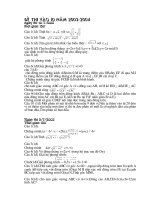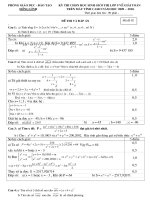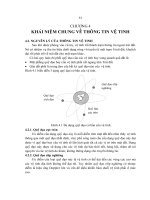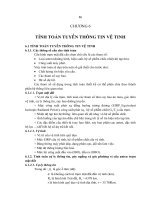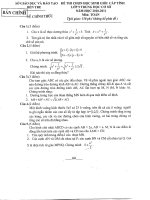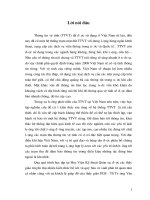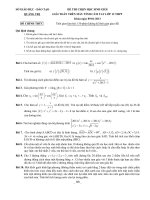Giải đề công nghệ vệ tinh
Bạn đang xem bản rút gọn của tài liệu. Xem và tải ngay bản đầy đủ của tài liệu tại đây (97.17 KB, 12 trang )
Question 36: The network’s Subnet Mask is 255.255.255.224, determine
its broadcast address if that a computer which has the address
192.168.1.1?
A. 192.168.1.255 B. 192.168.1.15 C. 192.168.1.31 D. 192.168.1.96
Đáp án: C
Question 37: Consider building a CSMA/CD network running at 1 Gbps
over a 1–km cable with no repeaters. The signal speed in the cable is
200000 km/sec. What is the minimum frame size?
A. 500 bits B. 5000 bits C. 1000 bits D. 10000 bits
Đáp án: D
Hướng dẫn:
Thời gian cần truyền đi cho 1 km là: 1/200000 = 5 x 10^-6 = 5 µsec
Thời gian truyền cả đi và về 1 km là: 5 x 2 = 10 µsec
Số bit truyền được là: 10^9 bps x 10 x 10^-6 sec = 10^4 bits = 10000
bits
Question 38: What is EIRP of a dipole antenna fed with a power of 100
mW?
0.1W≈ 100mW B. ≈A.
0.16W D. A, B and C are wrong≈C.
Đáp án: D
Hướng dẫn: (dựa vào slide 29 – Chương 3)
100 mW = 0,1 W
Gain = 0 dBd (do chuyển từ anten lưỡng cực sang đẳng hướng)
Do đó công suất nhận là 0,1W và công suất phát là ERP = 0,1W.
Ta có: 2,14 = 10log10 (EIRP / ERP)
EIRP / ERP = 1,639.⇒
EIRP = 16,39 W⇒
Question 39: We need to send 56 kbps over a noiseless channel with a
bandwidth of 4 kHz. How many signal levels do we need?
A. 1 B. 64 C. 2 D. 128
Đáp án: D
Hướng dẫn:
Áp dụng công thức Nyquist, ta có:
• 56000 = 2 x 4000 x log2L
log 2 L = 7, suy ra L = 2^7 = 128.
Question 40: Which modulation does a constellation diagram correspond
to?
A. QAM-4 B. PSK-4 C. PSK-2 D. QAM-2
Đáp án: B (câu này có cái hình)
- Mấy cái ghi logarit past từ word qua đây lỗi. Ví dụ log2L hiểu là
log cơ số 2 của L.
- Có phải dịch câu hỏi ra ko vậy, chắc khỏi nha.
Question 1: How many frequencies does a full-duplex QAM-64 modem use?
A. 1 B. 12 C. 6 D. 2
Đáp án: D
Question 2: An analog cellular system has 20 MHz of band-width and
uses two channels simplex of 25 kHz to provide a transfer service of
full-duplex. What is the number of full-duplex channels available by
cell for a reuse factor K = 4?
A. 400 B. 200
C. 100 D. A, B and C are wrong
Đáp án: C
Hướng dẫn:
Băng thông: 20 000 000 Hz
Băng thông của kênh là: 25 000 x 2 (simplex channel) = 50 000 Hz
(duplex channel)
Số kênh: 20 000 000/50 000 = 400 (channels)
K = 4: Số kênh có trên tế bào (cell) là: 400/4 = 100 (channels)
Question 3: A modem constellation diagram similar to figure. How many
bps can a modem with these parameters achieve at 1200 baud?
A. 4800bps B. 2400bps
C. 1200bps D. A, B and C are wrong
Đáp án: B
2 x 1200 = 4800 bps
Question 4: Ten signals, each requiring 4000Hz, are multiplexed on to
a single channel using FDM. How much minimum bandwidth is required for
the multiplexed channel? Assume that the guard bands are 400Hz wide.
A. 40800Hz B. 40400Hz
C. 44000Hz D. A, B and C are wrong
Đáp án: D
Hướng dẫn:
Có 10 tín hiệu, mỗi tín hiệu 4000 Hz. Dó đó, cần 9 dải tần (guard
bands)
Vậy, băng thông tối thiểu cần để ghép kênh là: 4000x10+400x9 = 43600
Hz.
Question 31: One class A address borrowed 21 bits to divide subnet,
the Subnet Mask is?
A. 255.255.255.248 B. 255.255.224.0 C. 255.255.192.0 D. 255.255.248.0
Mượn 21 bit =>2 octet giữa mượn tổng cộng 16 bit(255.255), octet
cuối mượn 5 bit:128+64+32+16+8=248
=>Câu A
Question 32: The radius of a cell in cellular network is 1600m. What
is the distance between centers of adjacent cells?
1600m≈ 2770m B. ≈A.
3200m D. A, B and C are wrong≈C.
Khoảng cách = r x căn bậc 2 của 3 = 2770 (đánh dấu căn nó lại
ko hiện lên :D)
=>Câu A
Question 33: Consider a noiseless channel with a bandwidth of 3000 Hz
transmitting a signal with 16 signal levels. The maximum bit rate can
be?
A. 48000 bps B. 3000 bps C. 12000 bps D. 6000 bps
Công thức Nyquist:BitRate = 2 x 3000 x log2(16)=24000
=>câu E(chắc dáp án sai ^^)
Question 34: A group of N stations share a Slotted ALOHA channel of 1
Mb/s. Each station emits in average a frame of 12000 bits/second. By
taking again the results obtained for Smax (maximum efficiency)
determine the maximum value of N that one can have?
700≈ 300 B. ≈A.
600 D. A, B and C are wrong≈C.
1 byte = 8 bit
1Mb = 1024 x 1024 byte
=>N = 1024 x 1024 x 8 / 12000 = 700
=>Câu B
Question 35: One takes the antenna gains into account; microwaves
transmitter has an output power of 0.1W at 2 GHz. The EIRP of the
transmitted signal is 10W. What is the wavelength of receiving
antennas parabolas?
0.64m≈ 1.2m B. ≈A.
0.32m D. A, B and C are wrong≈C.
lamda = c/f = 3x10^8 / 2x10^9 = 0,15(m)(đánh dấu lamda nó lại ko
hiện lên :D)
=>Câu D
Question 11: A typical Bluetooth data frame describe in figure. Which
field determines the active devices?
A. Header B. Access code C. Address D. Checksum
Ans: C
Question 12: If the diameter of receiving antennas parabolas is 30 cm,
what is the frequency concerned?
A. 1GHz B. 1MHz
C. 1kHz D. A, B and C are wrong
Ans: D
Question 13: The signal can be written .
What is the modulation type?
A. ASK-2 B. ASK-4 C. PSK-2 D. QAM-2
Ans: A
Question 14: The output power at transmitter is 1W, power received is
100mW. The gain is?
10 dB B. 100 C. 10 dB D. 1−A.
Ans: D
Question 15: A telephone line has a bandwidth of 4kHz. The
signal-to-noise ratio is 3162. For this channel the capacity is?
40000 bps≈ 46480 bps B. ≈A.
37944 bps D. A, B and C are wrong≈C.
Ans: A
C = B log2 (1 + SNR)
B is the bandwidth .SNR is the signal to noise ratio, capacity is the
capacity of the channel in bits per second
Câu 6-10:
Question 6: Suppose a transmitter produces 50W of power. The transmitter’s power is applied to a unity
gain antenna with a 900MHz carrier frequency. The close-in distance is d
0
= 100m. The value P
r
(d
0
) may be
predicted from equation, where G
t
, G
r
are antenna gain at transmitter, receiver, and L 1 is the system loss
factor. If P
r
is in unit of dBm, the received power is given by P
r
(d) = 10log
10
[P
r
(d
0
)/0.001] + 20log
10
(d
0
/d),
where dd
0
. What is the received power at a free space distance of 10km?
A. 24.5dBm B. 64.5dBm
C. +64.5dBm D. A, B and C are wrong
Answer: unity gain antenna: Gain = 0;
= c / f = 3 * 10^8 / 900000000 = 1/3
L = (4d / ) ^ 2
=> Pr (d0) = Pt * ^4 / (4d) ^ 4 = 2.475 *10^-10 (mW)
=> Pr(d = 10km) = -106.0635447 dBm.
Question 7: A channel has a bit rate of 5 kbps and a propagation delay of 20 msec. For what range of frame
sizes does stop-and-wait give an efficiency of at least 50%?
A. frame size < 100 bits B. 100 bits < frame size < 200 bits
C. frame size > 200 bits D. frame size < 200 bits
Answer: Tf / Tt >= 50% (1)
Tf = Fs / Bw (2) ; Tt = 20*10^-3 + Tf (3)
From (1) and (3) => Tf >= 0.02 (4);
From (4) and (2) => Fs >= 102.4 (bits);
With:
Tf: Time to transmit the frame; Tt: Total time include propagation delay time;
Fs: frame size; Bw: bandwidth
Question 8: Need to share with each subnet have 510 hosts maximum in a class B address, should use the
Subnet Mask?
A. 255. 255. 255.0 B. 255. 255. 255.192 C. 255. 255.252.0 D. 255.255.254.0
Answer: hosts = 510 => 9bits host => 23 bits net, IP class B => borrow 7bits => 255.255.254.0
Question 9: Suppose that 1 MHz is dedicated to the control channels and that only a control channel is
necessary by cluster; determine a reasonable distribution of the voice traffic channels for each cell, for the 9
reuse factors given previously.
A. 8 cells with 53 voice channels and 4 cells with 54 voice channels
B. 8 cells with 71 voice channels and 1 cell with 72 voice channels
C. 4 cells with 91 voice channels and 3 cells with 92 voice channels
D. A, B and C are wrong
Question 10: The signal can be written.
What is the modulation type?
A. QAM-4 B. PSK-4 C. PSK-2 D. QAM-2
This yields the four phases π/4, 3π/4, 5π/4 and 7π/4 as needed.
Còn câu 9 nợ lát nữa post nhe, tranh thủ mấy câu này trước! ^^
Mình đang làm từ câu 26 - 30, mà bí 2 câu 26 và 30, có bạn nào giúp ko, tìm mãi ko thấy cái nào dính tới 2
câu này hết
3 câu làm xong :
Question 27: In the cellular network, Q = D/R called co-channel reuse ratio. Suppose i = 3 and j = 1. What is
the Q?
A. 6 B. 6.24
C. 4.58 D. A, B and C are wrong
Đáp án : C. Theo slide 13 chương 5
Question 28: For the network address 172.16.0.0/16. How many subnets this network can be split up?
A. 16 B. 2
14
C. 2
16
D. A, B and C are wrong
Đáp án : C
Question 29: The telephone line is now to have a loss of 20dB. The input signal power is measured as 0.5W,
and the output noise level is measured as 4.5W. Calculate the output SNR in dB?
A. 30.5dB B. +30.5dB
C. 89dB D. A, B and C are wrong

